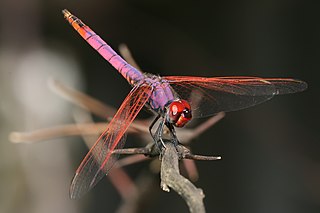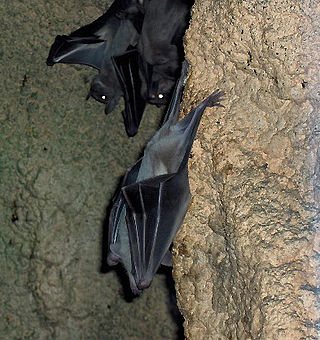This article is a list of biological species, subspecies, and evolutionary significant units that are known to have become extinct during the Holocene, the current geologic epoch, ordered by their known or approximate date of disappearance from oldest to most recent.

Woermann's bat or Woermann's fruit bat is a species of megabat in the family Pteropodidae. It is monotypic within the genus Megaloglossus. It is found in Angola, Benin, Cameroon, Central African Republic, Republic of the Congo, Democratic Republic of the Congo, Ivory Coast, Equatorial Guinea, Gabon, Ghana, Guinea, Liberia, Nigeria, Sierra Leone, Togo, and Uganda. Its natural habitats are subtropical or tropical moist lowland forests and moist savanna.

The Ceram fruit bat or Seram flying fox is a species of megabat in the family Pteropodidae. It is endemic to the mountainous forests of two Maluku islands, Buru and Seram, including the Manusela National Park on Seram. They were once present on the nearby Ambon Island, but probably not anymore. The habitat has an area of less than 20,000 km2, and is decreasing due to logging. For this reason, and because of hunting by the local population, these species are listed as vulnerable by the IUCN since 1996.

The long-haired fruit bat, also known as the long-haired rousette, is a species of megabat in the family Pteropodidae. It is the only member of the genus Stenonycteris. It was formerly classified in the genus Rousettus until a 2013 phylogenetic study found it to belong to its own genus and tribe.

Trithemis is a genus of dragonflies in the family Libellulidae. They are commonly known as dropwings. There are over 40 species, mainly from Africa; two are endemic to Madagascar, and five can be found in Asia. They are found in a wide variety of habitats; some species being adapted to permanent streams in forests, and others being capable of breeding in temporary pools in deserts.
The Azagnyi fruit bat, also called the western Woermann’s fruit bat, is a species of megabat found in Africa.

The Rousettinae are a subfamily of megabats. Taxa within this subfamily include:

Genettinae is a subfamily of the feliform viverrids. It contains all of the genet species and the oyan species.






